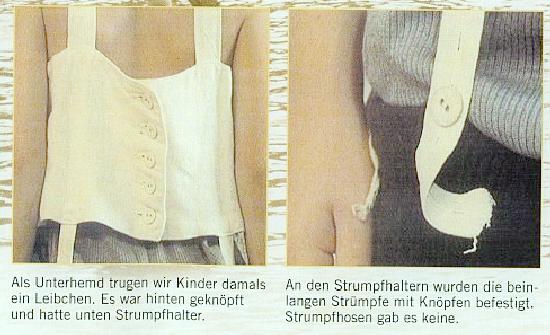
Vintage German Clothing: Cloth Leibchen (1940s-50s)

Figure 1.--The German text under the photographs of leibchen here reads in translation: "On top of our undershirts, we children usually wore a Leibchen. It was buttoned in back and had hose supporters below. The hose supporters were
fastened to extremely long stockings by means of a button sewn to the
stocking top. Tights had not yet been invented." Notice the ribbed
construction of the stocking shown--ribbing that would make the
stockings fit the legs more elastically and be both sturdier and warmer
in colder weather.
|
The basic German stocking supporter garment was a Leibchen. Here we see a standard child's Leibchen worn by boys and girls in Germany during the 1940s and 1950s. The Leibchen was a vest-like garment worn under a boy's shirt to which hose supporters were sewn or otherwise attached. The back view
shows the buttons opening in the rear. This model has two elastic garter
straps (sometimes referred to as Strapsen) attached to the bodice in
back with undoubtedly two others, not shown, in front--thus making four
garters (two for each stocking). At the right we see an illustration of one of the straps attached to a ribbed stocking with a button sewn onto it. Notice that there are additional buttonholes in the strap (Strumpfhalter) so that an adjustment can be made for the length of the stocking and the boy's height.
Long stockings were commonly worn by German children, both boys and girls. The purpose of the Leibchen was to hold up long stockings. Thus the chronology of these garments is strongly associated with the wearing of long stockings in Germany.
Notice the ribbed
construction of the stocking shown--ribbing that would make the
stockings fit the legs more elastically and be both sturdier and warmer
in colder weather. The hose supporters were
fastened to extremely long stockings by means of a button sewn to the
stocking top. Tights had not yet been invented."
Chronology
The photographs her show a child's Leibchen (for either a boy or a girl) from the period after World War II--i.e, in the late 1940s or early 1950s. This was the standard Leibchen worn by boys and girls in Germany during the 1940s and 1950s.
One garment discussed in the German clothing section was a "Leibchen"--a vest-like garment worn under a boy's shirt to which hose supporters were sewn or otherwise attached. (I don't believe the German boys had safety pins at the tops of their garters as the American boys usually did.) The Leibchen ordinarily buttoned up the back and was apparently made of some sturdy material (jean cloth?) that would take the strain of the attached hose supporters. This may be the garment which the two cyclists in your pages on German Long Stockings are wearing although one of your German contributors in "Long Stockings: Length" mentions that older boys "had shorter garters fixed at a waist belt similar to that worn by their mothers, but of course without all the adornment of women's garter belts." Note that the stockings are very long in these pictures and that the supporters fasten very high on the leg under very short shorts.
Chronology
The garment depicted here seems to be the standard Leibchen worn by
boys and girls in Germany during the 1940s and 1950s.
Construction
Here we see in the left view a back view of a German Leibchen. The back view
shows the buttons opening in the rear. This model has two elastic garter
straps (sometimes referred to as Strapsen) attached to the bodice in
back with undoubtedly two others, not shown, in front--thus making four
garters (two for each stocking).
Button Straps
At the right we see an illustration of one of the straps attached to a ribbed stocking with a button sewn onto it. Notice that there are additional buttonholes in the strap (Strumpfhalter) so that an adjustment can be made for the length of the
stocking and the boy's height. Althhough some German Leibchen came
with shiny metal clips at the ends of the elastic garters, like
American hose supporters, button fastening at the top of the stocking
seems to have been more common.
Attachment Alernatives
The double photo here with the Leibchen on the left and the stocking and button
on the left (already loaded) shows a garment with the supporter
(Srumpfhalter) straps already attached. We can't see the four ends,
but I suspect that this model has the metal clip and button clasps
similar to American hose supporters, although of course the straps may
simply end in a button hole for a stocking with buttons sewn on. The
three new images (from Birte's book) all show waist buttons for
attaching the Strumpfhalter and have no garters already sewn onto the
Leibchen. This difference is worth noting. Also the three new images
appear to have buttons at the side for only two garters as opposed to
four garters in front and in back--another difference.
Material
The Leibchen here is made out of sturdy white cotton fabric of a certain weight (the German equivalent of jean or cambric) so that the hose supporters
(Strumpfhaltern) won't pull the garment out of shape.
Age
This appears to have been the standard style of Leibchen for boys and girls until about the age of 10 years, although there seems to be some evidence that older boys occasionally wore a similar style of Leibchen (probably buttoning
in front rather than in back) when they were wearing very long stockings (for very short pants or for skiing, for instance) and needed the garters to be longer than would be the case with a garter belt.
HBC

Navigate the Boys' Historical Clothing Web Site:
[Return to ther Main vintage clothing garment page]
[Return to the Main German Leibchen page]
[Introduction]
[Activities]
[Biographies]
[Chronology]
[Clothing styles]
[Countries]
[Topics]
[Bibliographies]
[Contributions]
[FAQs]
[Glossaries]
[Satellite sites]
[Tools]
[Boys' Clothing Home]
Created: 9:44 PM 2/27/2006
Last updated: 1:34 AM 4/20/2006


